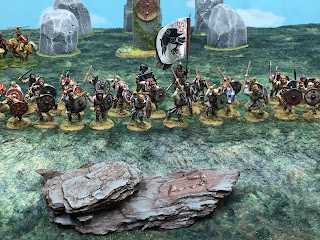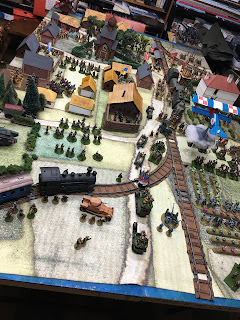Attended the HMGS Fall In convention again. Unfortunately, my son Nick had college committments so I attended by myself. Still, a great time and a particularly well-organized event. Also, being of Polish descent, this convention's theme, "Poland Through the Ages" had a special appeal for me. I put on two games, one set in The Deluge and the set in the Polish-Bolshevik War, more on them below.
The first game in which I played, on Friday afternoon, was Howard Whitehouse's delightfully retro A Gentleman's War, using classic toy soldiers with colorful, not-found-in-nature scenery. Set roughly in a Victorian/Edwardian era, it involved an invasion of England by the dastardly French who sneaked over the Channel whilst no-one was looking
A French onion seller/intelligence agent
I commanded the center of the French line but not for long.
A gallant charge by my curassiers was magnificently disastrous
The second game was the one I GM'd, this was Robbing Madonna, very loosely based on the siege of the Jasna Gora monastery near Czestochowa, the location of the famed Black Madonna icon, by the Swedes during the Deluge of 1655. I used an adaption I had made of Science vs. Pluck, which is basically a role-playing game but where the players take the role of commanders of military units, all on the same side and the GM controls the opposition. SvP is designed for the British colonial campaigns in the Sudan so I had to make a few changes to adapt it the Baroque era warfare, calling the modification Zagloba vs. Pluck.

In this game, the players commanded the Swedish forces tasked with capturing a fortified monastery containing a large treasury of donations, the capture of which would enhance the Swedish warchest. I had 11 players, 9 commanding a regiment sized unit, one player I had assisting me in running the Poles' garrison and partisan forces and one player as Mother Courage, head of the Swedish camp-followers. This latter was played with great aplomb by Howard Whitehouse himself.



The rules provide for each turn to have a shifting time scale, from one minute up to days, based on the players intentions and the GM's plans for the opposition. The players started with an attempt at a ruse, having the camp followers appear to be fleeing to the monastery chased by a regiment of Scottish mercenaries. This attempt at a Trojan horse-type of attack failed when the Polish commander did not buy the ruse. Being fired upon by the garrison, the camp followers and Scots rushed the walls. Mother Courage herself attempted to drive a flaming vodka cart against the gate but ending up immolating herself.

In the mean time, another Polish regiment serving with the Swedes, this one of winged hussars, decided to switch sides and attacked the Scots as they retreated from attack. Although the hussars inflicted some casualties, they were attacked from the rear and routed but not before the hussars' commander escaped to the fortress to become another Polish leader. He later sneaked out of the fortress and organized the local partisan forces who would have devastating effect on the Swedish operations.
Initial siege operations began but the Swedes soon realized that their light guns were making too slow an impression on the walls and winter was indeed coming. The Swedish commanding general set off for Krakow to seek heavier guns while much time was wasted in a mining operation rendered futile because the Swedes French engineering officer failed to realize that the ground under the fortress was solid rock.
There was some attempts for a negotiated surrender but the Polish garrison was feeling pretty confident. The siege dragged on while the weather continued to deteriorate. A Polish sortie proved to be unsuccessful due to the doughty Scots who nevertheless suffered heavy casualties.
The much hoped-for heavy guns were captured on the road by Polish partisans and the Polish light cavalry who had been serving with the Swedes managed to steal the Swedish payroll chest and set off to join the partisans. The Swedes were left with a last do-or-die attempt to assault the walls in which a minor breach was achieved by use of a petard. The assault was bloodily repulsed ending any chance of Swedish success and the game. Despite the frustrating result, all the players seemed to have really enjoyed the game and threw themselves into it with gusto.
On Saturday I ran my other game, The Twelve Chairs. Set during the Polish-Bolshevik War, it was inspired by an old Mel Brooks comedy about a search for the family jewels belonging to the Vorobyninov family that had been secreted in the chair seats of the formal dining room set. In the game, the tide of revolution and civil war resulted in them being scattered over old Ukrainian manor of the family. I had six markers hidden on the table, each one representing two chairs. At the end of the game, a player rolled a dice for each chair they possessed and a roll of a 6 indicated that they had a portion of treasure. So it was really like a giant scavenger hunt but with armored trains and heavy artillery. Each player had several infantry or cavalry units, some type of vehicle, a commander and a group of "treasure-hunters" who had extra chances to search for the treasure. I had four Polish players, five Bolshevik players, a Ukrainian player, a White Russian player, an Anarchist player, a player controlling the odd mix of nobles and retainers inhabiting the two manor houses on the board, and one player controlling a single very lost British armored car under the control of Capt Blackadder and his batman Baldrick.

The action in the game was too confusing to give a detailed narrative but it broke down into a battle between the main Red infantry force along with some Red sailors battling the Anarchist and Ukrainians over the manor houses. This all went for naught when the manor inhabitants were able to sneak out of the mayhem with their chairs in tow. The Red command armored train and heavy artillery battled the Whites while most of the Polish players ignored the fighting and searched the village for the treasure.
There were some long range firing between the Red armored train and the Polish Blue Army train. The Red cavalry and Polish cavalry providing the fiercest battle, wiping each other out in repeated charges up the stairs to the second floor of an inn where some of the chairs were stored. The remnants of the Polish cavalry were able to finally secure these chairs.

Perhaps the highlight of the game was when pilot of the Kosciuszko Escadrille plane supporting the Polish cavalry - this was American flyer and future movie producer Merion Cooper, spotted some of the chairs in the railroad water tower. Barrel rolling, he scooped the chairs out but then immediately ran into a wall of machine gun bullets put up by the Reds and crashed. Surviving he still made it off the board with his chairs, thus ensuring that a movie about a giant monkey would be made. The other memorable moment was when Blackadder managed to convince some of the Polish troops who had found a chair that Baldrick was really Queen Mary and they should turn over their chairs to her as a welcoming gift - amazingly they did so.

From a military standpoint, the end result was that half of the board was under red control and half under Polish control. Three players, out of five who had gotten the chairs, ended up sharing in the actual treasure, the Red army player, the Polish cavalry player, and Blackadder. I think all the players enjoyed the game.



























































